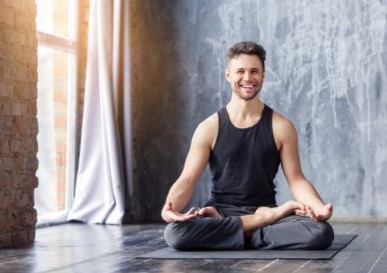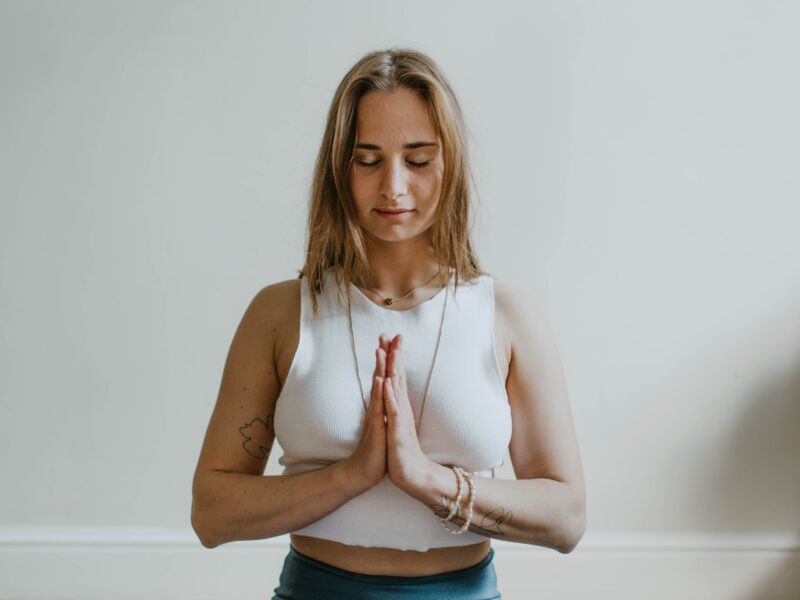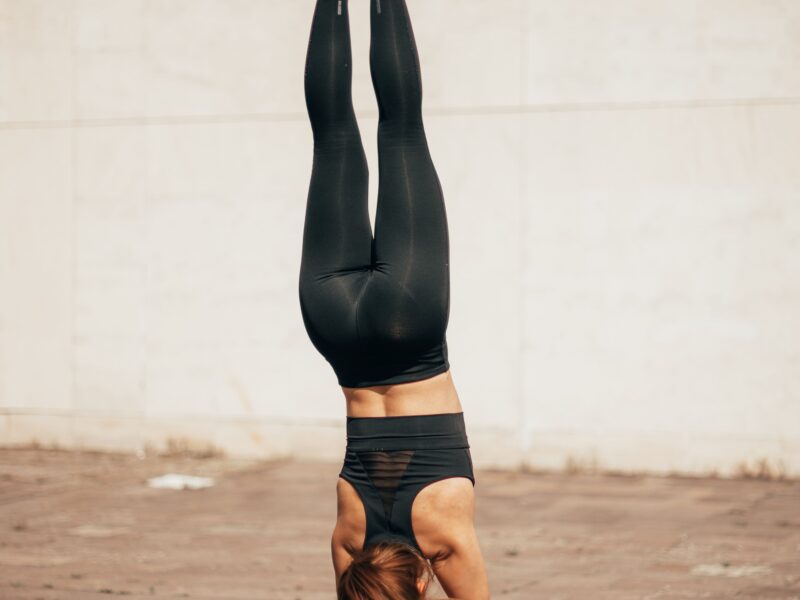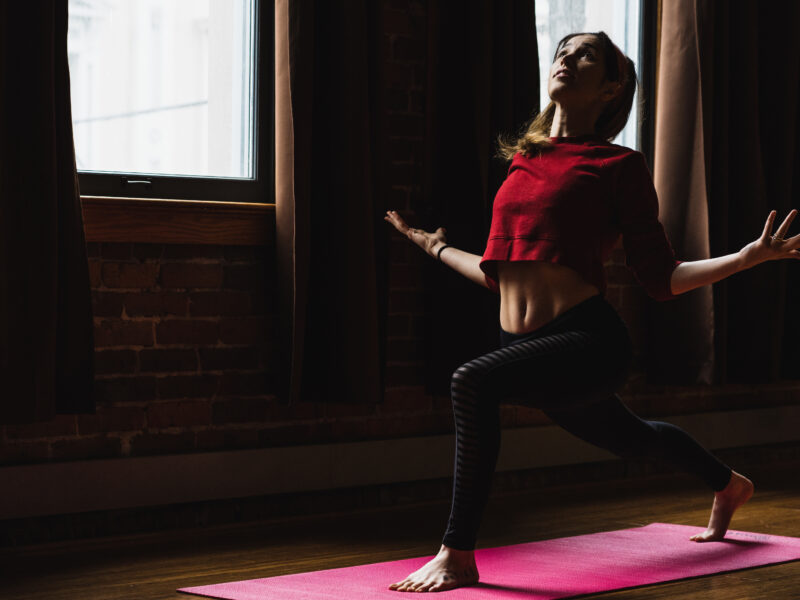If you haven’t already experienced the soothing powers of yoga firsthand, there’s ample evidence to support adding the practice to your pain fighting arsenal. Here are eight types of pain and how they might benefit from enlisting your yoga mat or meditation cushion, all backed by science.

By Yj Editors
NECK PAIN
Meditation may be the answer to easing recurring or chronic neck pain, a 2o15 study in The Journal of Pain suggests. Researchers found that a majority of study participants who experienced chronic neck pain reported a significant reduction in pain and pain-related complaints after eight weeks of jyoti meditation practice, a traditional Indian meditation technique involving the repetition of mantras and focus on the third eye.
“Chronic pain is frequently associated with distress, and neck pain specifically is related to high levels of stress,” says Andreas Michalsen, M.D., one of the study researchers and a professor at Charité University Berlin. He hypothesizes that any of a variety of meditation forms shown to relieve stress, including mindfulness meditation, could offer similar benefits for pain relief by modulating neurobiological pain signals and pathways in the brain. In other words, meditation essentially eliminates the suffering related to pain.
 BACK PAIN
BACK PAIN
One more reason to petition your boss for yoga classes at the office? Practicing in the workplace was shown to reduce employee stress and ease back pain in a study published in the journal Occupational Medicine.
Study participants, who were employees of the British government, were asked to practice yoga for 5o minutes once a week for eight weeks. They were also allowed to practice up to twice a week for 2o minutes at home with a DVD. When compared with a group that did no yoga at all, the yoga practitioners reported lower levels of stress and sadness as well as less back pain. Though the study was small, it adds to a growing body of research that confirms yoga’s many pain-reducing benefits.
CHRONIC PAIN
Combining the mindful practice of yoga and meditation with traditional medical treatment can help chronic pain sufferers find more relief than medicine alone, according to research conducted by Patrick Randolph, Ph.D., at Texas Tech University. His study followed 78 patients with chronic pain, which unlike acute pain, is often not associated with a particular injury and can come and go over months or even years with no pattern. In addition to whatever medical treatment they were undergoing before, during, and after the study, the participants attended several cycles of two-hour classes that used gentle poses with an emphasis on mindfulness. They were also required to meditate for a minimum of 45 minutes per day, six days per week, with the aid of an audiocassette tape. Afterward, 79 percent said their condition somewhat or greatly improved.
“Most people who experience chronic pain also experience depression or anxiety,” says Randolph, former director of psychological services at the International Pain Institute at Texas Tech University’s Health and Science Center. “So when we treat chronic pain, we need to treat both the body and the mind at the same time.”
MULTIPLE SCLEROSIS
In welcome news, yoga can help improve mobility and quality of life for people living with the debilitating disease of multiple sclerosis, research at Rutgers University found. In the study, women with MS learned about yoga philosophy and practiced deep-breathing exercises and restorative poses for 9o minutes twice a week. After eight weeks, they were better able to walk for short distances and longer periods of time, had better fine-motor coordination, and showed improvements in balance while reaching backward. They also reported less pain and fatigue than when they started the trial, according to the researchers.
 MIGRAINE
MIGRAINE
A study out of the University of Rajasthan, published in the journal Headache, showed that yoga can help reduce the intensity and frequency of migraines. In the study, migraine sufferers practiced a sequence of yoga poses, breathing exercises, relaxation, meditation, and mantras for three months. The result? Participants’ migraine problems improved, as did their heart rate. “Scientists have been considering serotonin, a brain chemical, to be a crucial factor for headaches. They think low serotonin levels might cause blood vessels to dilate and cause migraines. And yoga is known to improve levels of serotonin,” said researcher Neha Sharma.
CANCER
If you or a loved one has been diagnosed with cancer, this news is for you. Participating in a yoga program helped cancer survivors feel better physically, emotionally, and spiritually, according to preliminary findings from researcher and yoga therapist Cheryl Fenner Brown. Her study also showed a correlation between practicing the “contemplative” aspects of yoga—intention setting, mudra, pranayama, and final relaxation—and a greater increase in emotional and spiritual well-being.
“Participation in the Healing Yoga for Cancer Survivorship (HYCS) protocol showed an 8.8 percent decrease in physical symptom severity (i.e., fatigue, sleep disturbance, pain, and interference of side effects), a 6.6 percent increase in functional well-being (i.e., ability to work, concentration, ability to sleep, and acceptance of illness), a 1o.3 percent decrease in emotional symptom severity (i.e., sadness, nervousness, worry about recurrence, and hopelessness), and a 13.9 percent increase in spiritual well-being (i.e., peacefulness, life purpose, harmony, self reliance, and gratitude),” says Fenner Brown, who developed the HYCS protocol. Study participants included 19 cancer survivors (both men and women) with an average age of 56 years and an average time since completing radiation and chemotherapy treatment of just over three years. Their diagnoses included breast cancer; lymphoma; leukemia; melanoma; and neuroendocrine, endometrial, ovarian, brain, rectal, and kidney cancers.
RHEUMATOID ARTHRITIS
Promising findings out of the University of California, Los Angeles (UCLA) suggest that Iyengar yoga may be effective at offering relief for patients with rheumatoid arthritis (RA), an autoimmune disease that causes fatigue, stiffness, and joint pain and can lead to joint and bone deterioration if left untreated. In the study, Iyengar yoga classes were offered to 11 women with RA for 6 weeks, while a control group of 15 women continued with their regular lives for the duration of the study. The results, says UCLA pain researcher Kirsten Lung, showed that the yoga practitioners had improved in several areas—including general health and vitality— while the control group stayed the same.
However, the yoga practitioners did not report a difference in their pain levels—only their ability to cope with the pain. But it was also determined that six weeks was probably not long enough to make a firm determination about whether yoga might be able to help pain. And, as most pain doctors will tell us, the ability to cope better with pain means less stress. Less stress means less muscle tension and cortisol in the body, which often naturally leads to less
actual pain.
CARPAL TUNNEL
Although yoga teachers have been using yoga to successfully treat carpal tunnel syndrome for years, the first scientific evidence of its effectiveness came in a 1998 article in the Journal of the American Medical Association. In a randomized trial of 42 patients conducted at the Medical College of Pennsylvania, half of the patients took part in an eight-week program of Iyengar Yoga while the control group received wrist splints. Marian Garfinkel, the study’s lead author and a senior teacher of the Iyengar method of yoga, taught the subjects in the yoga group 11 yoga postures designed to strengthen and stretch each joint in the upper body, along with Savasana. After the intervention, the people who had done yoga had less pain and a significant improvement in grip strength compared with the controls. While the group studied was small, and a longer-range study might be more revealing, the results were encouraging.
This article was first published in the print edition of Yoga Journal Singapore, which is now Yogahood Online.






